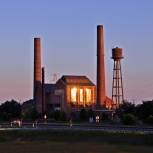
The Kortrijk Region
The Kortrijk region is a modest tourist destination compared to nearby cities like Bruges, Ypres and Ghent. However, the Kortrijk region is renowned for its network of specialized SME's aiming at niche markets and which employ both a Belgian and French workforce. The region enjoys a healthy economy with lower than average unemployment rates.
Because the Kortrijk region is running out of space, “conservation through development” is one of the leading principles in its spatial development: building higher, using the existing space more intensively by adding and combining functions, reconverting and redeveloping derelict sites.
A fair amount of the built-up space in the Kortrijk region has been taken by 8.285 heritage buildings and sites. Some of these are vacant due to their condition, functional restraints or complex context. Because of its reasonable share in the built-up space, architectural heritage can act as an important leverage for spatial planning and development. That is why vertically and horizontally integrated heritage management is a necessity. It is needed at both macro and micro-level.
The 13 cities and municipalities of the Kortrijk region engaged in INT-HERIT URBACT implementation network because of the leverage the project offers for heritage management on different levels.
The spatial and socio-economic development of the region is supported by the intermunicipal organisation Leiedal. Leiedal came into being in 1960 on the initiative of the municipalities of the Kortrijk region. In the past five decades, Leiedal developed into a multifaceted intermunicipal cooperation. Locally driven development forms the key factor.
